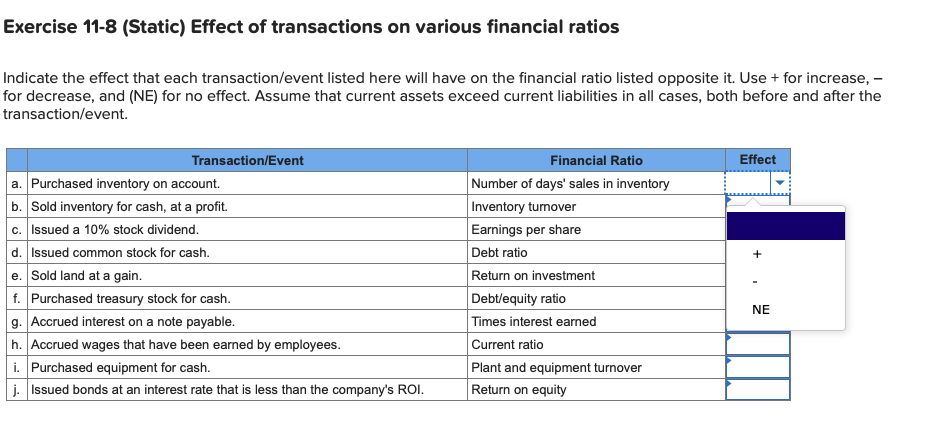Indicate the effect that each transaction/event listed here will have on the financial ratio listed opposite it. Use + for increase, - for decrease, and (NE) for no effect. Assume that current assets exceed current liabilities in all cases, both before and after the transaction/event.
Indicate the effect that each transaction/event listed here will have on the financial ratio listed opposite it. Use + for increase, - for decrease, and (NE) for no effect. Assume that current assets exceed current liabilities in all cases, both before and after the transaction/event.
Financial Reporting, Financial Statement Analysis and Valuation
8th Edition
ISBN:9781285190907
Author:James M. Wahlen, Stephen P. Baginski, Mark Bradshaw
Publisher:James M. Wahlen, Stephen P. Baginski, Mark Bradshaw
Chapter5: Risk Analysis
Section: Chapter Questions
Problem 22PC
Related questions
Question

Transcribed Image Text:Exercise 11-8 (Static) Effect of transactions on various financial ratios
Indicate the effect that each transaction/event listed here will have on the financial ratio listed opposite it. Use + for increase, –
for decrease, and (NE) for no effect. Assume that current assets exceed current liabilities in all cases, both before and after the
transaction/event.
Transaction/Event
Financial Ratio
Effect
a. Purchased inventory on account.
b. Sold inventory for cash, at a profit.
c. Issued a 10% stock dividend.
d. Issued common stock for cash.
Number of days' sales in inventory
Inventory tumover
Earnings per share
Debt ratio
e. Sold land at a gain.
Return on investment
f. Purchased treasury stock for cash.
g. Accrued interest on a note payable.
h. Accrued wages that have been earned by employees.
i. Purchased equipment for cash.
j. Issued bonds at an interest rate that is less than the company's ROI.
Debt/equity ratio
NE
Times interest earned
Current ratio
Plant and equipment turnover
Return on equity
Expert Solution
This question has been solved!
Explore an expertly crafted, step-by-step solution for a thorough understanding of key concepts.
This is a popular solution!
Trending now
This is a popular solution!
Step by step
Solved in 2 steps with 1 images

Knowledge Booster
Learn more about
Need a deep-dive on the concept behind this application? Look no further. Learn more about this topic, accounting and related others by exploring similar questions and additional content below.Recommended textbooks for you

Financial Reporting, Financial Statement Analysis…
Finance
ISBN:
9781285190907
Author:
James M. Wahlen, Stephen P. Baginski, Mark Bradshaw
Publisher:
Cengage Learning

Corporate Financial Accounting
Accounting
ISBN:
9781305653535
Author:
Carl Warren, James M. Reeve, Jonathan Duchac
Publisher:
Cengage Learning

Accounting (Text Only)
Accounting
ISBN:
9781285743615
Author:
Carl Warren, James M. Reeve, Jonathan Duchac
Publisher:
Cengage Learning

Financial Reporting, Financial Statement Analysis…
Finance
ISBN:
9781285190907
Author:
James M. Wahlen, Stephen P. Baginski, Mark Bradshaw
Publisher:
Cengage Learning

Corporate Financial Accounting
Accounting
ISBN:
9781305653535
Author:
Carl Warren, James M. Reeve, Jonathan Duchac
Publisher:
Cengage Learning

Accounting (Text Only)
Accounting
ISBN:
9781285743615
Author:
Carl Warren, James M. Reeve, Jonathan Duchac
Publisher:
Cengage Learning